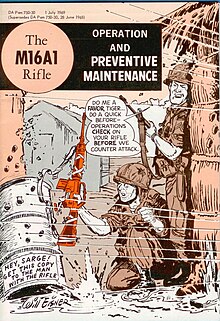Firearm maintenance
This article's tone or style may not reflect the encyclopedic tone used on Wikipedia. (October 2012) |


Firearm maintenance (or gun care for short) is a series of routine
When a firearm is presented with physical damage related to the ordinary use of the firearm, or when a firearm malfunctions in a life-threatening manner, a professional gunsmith should perform advanced maintenance to determine if the firearm is repairable and or safe to shoot anymore.
Necessity

An inadequately maintained firearm will often accumulate excessive fouling and dirt within the barrel and receiver, which not only can clog up the rifling and decrease the firearm's accuracy and precision, but can also interfere with the proper operation of the action and lead to potentially dangerous malfunctions. Furthermore, some of the fouling and dirts are either corrosive themselves, or capable of making the firearm vulnerable to rusting and wear, and thus can lead to irreversible damages to the firearm over time.
The consequences of neglecting proper maintenance can be serious. For instance, during the
With these measures, the reliability of the M-16 improved considerably.[3]
Cleaning
The ordinary firing action releases fine particles of gunpowder, metals (mostly lead and copper from the bullet moving over the riflings) and other contaminates into the inner spaces of a firearm, which may cause malfunctions or in rarer cases of extreme buildup may raise the barrel pressure too high causing the firearm to explode (catastrophic failure) upon being fired. It has been widely reported that firearms without a spring to control the inertia of the firing pin require constant cleaning of the bolt assembly, as extremely dangerous phenomena such as slamfire may occur. Slamfire is a malfunction in which a firearm which is normally semi-automatic may temporarily and involuntarily become fully automatic, firing repeatedly — without another pull of the trigger — until the firearm is out of ammunition or jams.
Every major firearms manufacturer provides detailed information on the proper methods used to disassemble, clean and then reassemble a firearm they produced. This information is usually packaged with the firearm. In the event that this information is not present with the firearm at the point of purchase, it can usually be obtained from the manufacturer.
There are many different types of weapon and firearm cleaning kits available on for sale. These kits will give you the necessary tools and materials to properly clean your firearm safely and effectively.[4] These kits help keep your firearm stay maintained and properly lubricated, making the firearm last longer without failure.
However, pre-made cleaning kits often do not contain everything a specialty gun owner may want or need. This is why many gun owners build their own custom cleaning kits which include extra materials or specialized parts to best keep their weapon in proper order.[5]
Lubrication
Firearms produce massive momentary forces upon firing a bullet. A typical
When in an extreme and life-threatening situation such as preparing for combat, the manufacturer's recommended lubricants may not be available to soldiers, or others who may enter these scenarios. If there is time to perform firearm maintenance before a life-threatening emergency (such as daily cleaning of a rifle in a combat zone) it may become necessary to use other sources of lubrication, as a firearm will function better with some lubricant than it will with none. One United States Marine Corps sergeant recounts that synthetic motor oil performed better than standard military issued lubricant in extreme conditions.[7] However it is advisable to immediately return to the standard recommendation of the firearm manufacturer when conditions allow.
Gun owners need to keep in mind that not all gun oils are made for the same thing. Some are specifically used for lubrication, while others are for cleaning. Greases may also be used in heavy duty situations where oils are not sufficient.[8]
Safety
It is critically important that a firearm is free of ammunition before beginning maintenance. The
See also
References
- ^ "Best Gun Cleaning Kits". Norman. 5 June 2022.
- ^ Eisner, Will. "The M16 A1 Rifle Manual by Will Eisner". Issu.com. Retrieved 28 November 2020.
- ISBN 978-0-87341-824-9., p. 291
- ^ "Seven Things You Need to Clean a Gun". Range365. Archived from the original on 2017-09-12. Retrieved 2017-09-12.
- ^ "Gun Cleaning Kits and Various Components". Gun University. 29 April 2022.
- ^ "Velocity and Pressure Data" (PDF). SAAMI. Archived from the original (PDF) on 2015-03-19.
- ^ "Letter Re: Synthetic Motor Oil as a Gun Lubricant". Survival Blog. Archived from the original on 2014-02-09. Retrieved 2013-12-28.
- ^ "Suitable Gun Oils and Greases". Gun University. 20 May 2022.
- ^ "NRA Gun Safety Rules". National Rifle Association of America. Archived from the original on 2013-12-15. Retrieved 2013-12-28.
